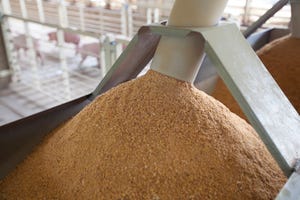Farmland rental costs and volatile fertilizer prices comprise the two primary drivers of increasing costs, and, according to Alan Miller, seed prices also will be up 5-10% in the coming year.
October 20, 2011

Growing an acre of corn, soybeans or wheat in 2012 will cost producers a lot more than it did this year, says a Purdue Extension agricultural economist.
Farmland rental costs and volatile fertilizer prices comprise the two primary drivers of increasing costs, and, according to Alan Miller, seed prices also will be up 5-10% in the coming year. Pesticide prices will vary by product.“Preliminary budgets show variable costs for rotation corn increasing by 16%, soybeans by 15% and wheat by 12% as compared with our January 2011 budgets," Miller says.Estimates show that despite a recent decline in corn and soybean prices, the income potential from continuous corn on average -yield ground is higher relative to rotation soybeans than in most years. Miller says the income potential may be even better for continuous corn on Indiana's best farm ground.“The markets are still signaling that they want more corn in 2012, so the question is whether farmers will listen," he says. “There probably will be more corn next year.”Even with input costs up in 2012, Miller says farmers can begin to manage their profit margins now, such as by pricing fertilizer for 2012. Fertilizer prices are lower this fall than they are expected to be next spring.Another area Miller says growers should be looking at is cash rents.“It's hard to figure out a fair amount of cash rent, especially in an environment with so much potential for quick commodity price declines and input price surges," he says. “We don't want to see another 2009 where grain prices dropped, costs increased and profitability disappeared. It's a challenging risk management environment for the farmers.”He urges farmers to be cautious and to try to hold down costs by thinking through all of their purchases.“Commodity producers need to still be working on being low-cost producers on a cost-per-bushel-produced basis," Miller says. “Growers need to manage the expected margin between the selling price of the corn and their costs. Try to lock in commodity prices and lock in prices on purchased inputs. Lock in profit margins and don't give up marketing strategies.”While many farmers may be tempted to take a wait-and-see attitude toward marketing the 2011 crop, Miller says that might not be the best idea. Instead, he says this is a good time to apply marketing skills to the management of input pricing. If crop prices recover, demand for inputs and input prices are likely to increase.For cash rents, he says flexible lease agreements could help both growers and landowners in a volatile period.“Try to help landowners understand the market and the volatility," Miller says. “Possibly look at flexible lease agreements instead of locking in cash rents in case inputs increase and commodity prices stay where they are at now or fall even further.”The bottom line, he says, is that producer vulnerability is a concern heading into 2012. Growers need to be proactive in managing their input pricing because input prices could rise even more if crop price prospects improve in the spring.For more information about 2012 input costs, check out Miller and Bruce Erickson's article “Crop Input Prices Surge” in the October 2011 edition of Purdue Ag Econ Report at www.agecon.purdue.edu/extension/pubs/paer/. Also check the Purdue Crop Costs and Returns Estimates for 2012 at www.agecon.purdue.edu/extension/pubs/id166_2012_AUG29_2011_final.pdf .
You May Also Like



